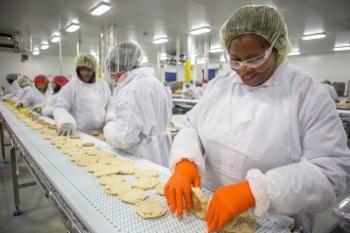Managers of Food Manufacturing operations, you have some very unique challenges that are often not a concern in other types of manufacturing operations. These are typically issues surrounding seasonality, sanitation, and product mix. At Shiftwork Solutions, we know how to help you design a shiftwork structure that maximizes your production capacity in spite of these complications.
Over the last 30 years, Shiftwork Solutions has worked with dozens of food manufacturing facilities. One thing that always strikes us is how complicated their production requirements are.
While a typical manufacturing facility will say βOur overtime is too highβ or βWe need to increase capacityβ, a food manufacturer will use these statements as only a beginning.
In this post, Iβm going to cover some of the βLow Hanging Fruitβ; those things that we go after when optimizing a food manufacturing plant.
Product Demand: Most food manufacturing facilities experience some degree of variability in their demand. For example, soft drink demand drops off in the winter while potato chip demand goes up as the Super Bowl approaches. The questions to answer are: (1) How big is the swing? (2) How predictable is the swing? (3) What are your labor options (Full Time v. Temps v. Overtime)? (4) What is the cost of training v. retaining? Are you willing to lose skills during a slow time? If not, what is the cost of keeping them around so they are there when you need them? (5) Can shelf life be used in such a way as to allow leveling out of production? (6) If you have multiple plants, can you keep some higher performers at capacity and allow the poorer performers to handle the variability?
Product Mix: If all lines make the same thing all the time, this is not an issue. However, this is almost never the case. The questions to answer are: (1) Does line X always take the same amount of people to run when it is running? If not, what is the variability? (2) Can multiple lines produce the same products or is each line the only line that can make certain products? (3) What is the cost of training your workforce to be able to operate multiple lines?
Sanitation: This is something 100% of food manufacturers must deal with. A typical solution is βWe shut down at night or on the weekend to cleanβ. This isnβt a bad idea except for 3 things: (1) Every time you shut down, you must startup. Start-ups are the least productive times for your lines. (2) Every time you shut down, you must clean. Cleaning = labor dollars. Shut down fewer times you will clean fewer times. (3) While you are cleaning, you are not producing. Why shut down for 8 hours (and lose 8 hours of productivity) when you really only need 4 hours? Scheduling sanitation to occur when you need it and only in the quantities you require will increase equipment availability and decrease labor costs. Cross-training operators to perform sanitation duties can often be the best solution.
Maintenance: When companies contact us, they are usually capacity constrained. This means maintenance has been pushed to the very edge of the week β Saturdays and Sundays. This can result in poor accomplishment rates as mechanics rush to fix everything in a very tight window. Spreading operations across more days will allow maintenance to be spread out as well. For example, if you go to a 24/7 production schedule, it does not matter when you take a line down, so take it down when you are able to do your best work.
Other areas that need to be considered are R&D, Quality, Supervision, Distribution, and Planning. Leave out any of these puzzle pieces and you will not get the complete result you are after.
Let us help you develop a better way to schedule your sanitation. Use our process of analysis and employee engagement to transform your workplace.
Call or text us today at (415) 858-8585 to discuss your operations and how we can help you solve your shift work problems. You can also complete our contact form and we will call you.

